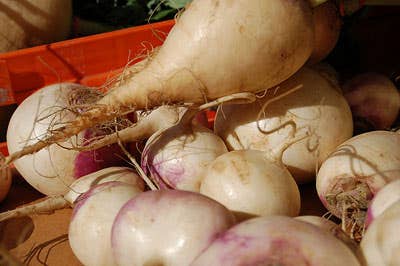
Winter Vegetables: Rutabagas
Despite being immortalized by Frank Zappa in his song "Call Any Vegetable," it seems to me that not many people enjoy rutabagas. Giant, overgrown, waxy turnips, these root-vegetable monsters are usually considered cheap filler to bulk up a casserole or mash. But with the Advanced Rutabaga Studies Institute declaring 2010 the "International Year of the Rutabaga," maybe it's time to re-evaluate them.
Rich in vitamin C and potassium, lower in carbohydrates than potatoes, and slightly sweeter and less peppery than regular turnips, rutabagas are both useful and delicious. But you can't eat them raw, so recipes, like this one for smashed rutabaga with roasted pears and ginger, have require you to mash, bake, or boil them into submission.
Nowadays, though, folks who like the taste of rutabagas are trying something more inventive: they're cooking them less. You can blanche them quickly in this rutabaga slaw, or you can simply roast them without a lot of oil or salt, as in this recipe for rutabaga oven fries. The other trick is to sweeten the heck out of them. This roasted rutabaga salad uses honey and apple juice to do just that. In fact, why not try making a dessert out of them? This rutabaga pie is flavored with ground ginger and cinnamon.
To my mind, though, the best recipes are the more traditional ones. German rutabaga fritters, or Steckrubenpuffer, are basically latkes made with a blend of grated rutabagas and potatoes. The traditional Finnish Christmas dish, lanttulaatikko, is just buttery whipped rutabagas that are put in a casserole dish and baked.
As Frank Zappa sings, "Call any vegetable/Pick up your phone/Think of the vegetable/Lonely at home." And it's clear that the rutabaga is the loneliest vegetable of all. But if you love it, it'll love you back.
Buying Tips
Season: Rutabagas are cool-weather root vegetables that grow best between late September and early December, and are harvested in the wintertime. Rutabaga fans say they're sweeter just after the first frost. They take forever to grow, so most areas only have one harvest a year.
Where to find it: You can get it mostly in the northern states, but because the clamor for rutabagas hasn't been historically loud, you might have a hard time finding it in supermarkets, so check local farmers' markets.
Price: Cheap. Rutabagas sell for between $1 and $2 per pound, with the average rutabaga weighing around two pounds.
Amanda Cohen is the chef and owner of Dirt Candy, a vegetarian restaurant in New York City.
Keep Reading
Continue to Next Story










